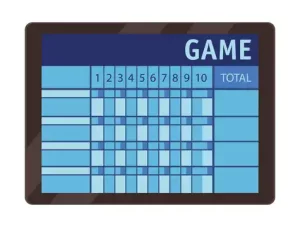Perhaps you’ve had the chance to visit the bowling alley with your friends and discovered that you won a few games quite easily. We’re willing to bet you’ve wondered what the average bowling score is and how you would compare it.
Are you competing against below-average players, or do you have the potential to be considered for competitive bowling tournaments?
If you are contemplating involvement with the latter, it would be worthwhile to thoroughly understand the competition and where you ultimately found yourself competing against the very best.

No matter your motivation, we have compiled comprehensive information on the average bowling score and how you can assess your performance against it. Continue reading to uncover all the details.
Contents
How Do You Score In Bowling?
To begin, it is worth delving into the fundamentals and understanding the scoring system of bowling.
During a game, each player participates in ten ‘frames’ and has the opportunity to make up to two throws in each frame. However, if you achieve a strike or a spare in the last frame, you earn an additional turn, but only in this final frame.
In essence, the scoring in bowling revolves around counting the pins that you manage to knock down in each frame and maintaining a cumulative record of the total count.
A strike in bowling occurs when you successfully knock over all the pins with your first throw, resulting in 10 points. Following a strike, the score from the entire next frame is added to the 10 points earned.
In bowling, a spare occurs when you successfully knock down all the pins within two throws. In the following frame, the score from your first throw is added to the score of the spare. This rule ensures that each frame is interconnected, adding an extra layer of strategy and excitement to the game.
What Is The Average Bowling Score?
Certainly, the typical score in bowling, as determined by the standard scoring method outlined in the preceding section, is contingent upon one’s skill level. What may be considered average for a league bowler will greatly differ from what is considered average for a beginner.

The scores we mention, which are achieved without any additional assistance like gutter barriers or the ramp designed for children, truly reflect the individual’s skill and ability in the game. It’s important to recognize and celebrate these scores as they showcase the player’s talent and dedication.
What Is A Perfect Game?
It is logical to determine the highest score in bowling as a point of reference to compare against an average score.
If our calculations are correct, achieving a perfect score of 300 in bowling is a rare occurrence, primarily seen at the highest levels of the game.
To achieve the highest possible score of 300, you need to score nine consecutive strikes followed by three final strikes in the last frame.
For those fascinated by world records, Ben Katola achieved an extraordinary feat at the bowling alley where he works as an assistant manager. In a completely vacant alley, he meticulously set up the pins and proceeded to score a flawless game in an astonishing 86.9 seconds. This remarkable display of skill and precision showcases the true artistry of bowling.
On the other hand, Fero Williams holds the remarkable record for the highest number of perfect games bowled, an astonishing 135 in total.
Average Score For Beginners
If you’ve never bowled before and need guidance on rules and average scores, you’re in the right place. Don’t worry, there’s no need to feel embarrassed. Bowling is a recreational and leisurely activity, so there’s nothing to fear. Rest assured, this article will provide you with all the information you need to enjoy the game to the fullest.
Typically, for someone who is playing the game for the first or second time, it is reasonable to anticipate scoring below 100 points, often below 90. However, there is always a chance of achieving a fortunate spare or a strike, and you might even discover that you possess a natural talent for the game!
Don’t be discouraged if your initial scores are not as high as expected; embrace the opportunity for improvement and enjoyment.
Average Score For A Recreational Player
If you’re someone who likes to bowl with friends and family, making it a fun day out with a few drinks, and treating it as a special occasion for birthdays or celebrations instead of a serious sport, then you can consider yourself a recreational player.
Even as a casual bowler, you may have accumulated some experience in the game, and perhaps you’ve even found yourself victorious more often than not in these matches.
In this setting, the average score for bowlers typically ranges from 90 to 150 points. This broad range encompasses what could be considered an ‘average’ score for most bowlers at this recreational level. It’s worth noting that while some may score below or above this range, the majority of bowlers tend to fall within this scoring spectrum.
Average Score For A-League Player
The next progression would be to venture into the realm of semi-professional bowling. If you consistently surpass a score of 120 in most games, and occasionally achieve even higher scores on exceptional days, it may be worthwhile to contemplate joining your local bowling league, provided you feel prepared for the challenge.
On average, a competitive bowler who wants to win a competitive match rather than playing recreationally should aim to score around 120 – 200, depending on the skill level of your league, which can differ per player. However, it’s important to note that scoring ranges can vary significantly based on factors such as lane conditions, equipment, and individual playing styles.
It’s always a good idea to practice and continuously improve your skills to consistently achieve higher scores and compete at a more advanced level.
Average Score For A Professional Player
If your true passion lies in making a career out of bowling, devoting your life to its practice, and striving to compete with the world’s top players, then the average score here holds a slightly different significance.
Before joining most professional leagues, you may be required to declare your average score, or at the very least, your scores in the bowling community should be known through word of mouth. This is often the case after achieving success in local leagues.
Regardless, for aspiring professional players, striving for excellence is imperative to compete with the best. Set your sights on achieving a flawless score, without falling significantly short.
To be considered at the level of most professional bowlers, you should aim for a score ranging from 220 to 280. Scoring below 200 would be considered quite poor.
How To Improve Your Bowling Score
To significantly enhance your bowling score, strive for strikes and spares while avoiding any open frames. Making this your top priority is crucial if you aspire to achieve a high score.
Professional bowlers approach the game quite differently from recreational players. Their goal is often to achieve a perfect game, and their score reflects their success in doing so.
If a professional player fails to earn a mark in their frame by achieving a spare or strike, their score will typically be slightly lower compared to other players.
To achieve this standard as a recreational player seeking actionable advice, it is crucial to master the technique of obtaining a mark. The key focus should be on two essential aspects to successfully secure a mark.
To maximize your bowling success, it’s crucial to direct your attention to the precise point where your ball connects with the pins. Ideally, you should aim for either the right or left pocket. This strategic focus should be complemented by refining your throwing technique.
To maximize your chances of knocking down all ten pins, it is important to aim for a straight roll that utilizes the point of impact effectively. By focusing on technique, you can enhance your precision and increase the likelihood of a successful outcome.
To optimize your throw, it’s crucial to minimize wrist movement, maintain your hand position behind the ball, and maintain a stable body posture. This will enhance your technique and overall performance.
When your ball travels straight and hits the foremost pin just slightly off center, known as the pocket, the resulting force should cause all ten pins to tumble down, resulting in a strike.
If you strive to accomplish this and fall short, you should have the ability to knock down the remaining pins and secure a spare to boost your score.
In Conclusion
And that concludes our presentation, revealing the skill averages for each aspect of a player’s bowling abilities.
To summarize, for a beginner player who is new to the game or has only played a handful of times, it is generally expected for them to score somewhere below or equal to 100 points, approximately.
This range takes into account the learning curve and the time it takes to grasp the rules and strategies of the game. However, it is important to note that individual performance may vary based on factors such as natural aptitude, practice, and dedication to improvement.
A skilled player who has achieved numerous victories and thrives on friendly competition or participation in local leagues would find a score within the range of 150 to 200 quite satisfying.
In professional bowling leagues, the benchmark for success is to score over 200. However, the true aspiration for most players is to achieve a flawless 300-game, which requires striking in every frame. As a result, their average score typically hovers between an impressive range of 220-270, showcasing their consistent high-level performance.
Bowling is predominantly a recreational game, where the primary objective is to have fun. While some approach it more seriously and find enjoyment in the competitive aspect, the level of competition is always dependent on the individuals you are playing with.
Achieving a score of 200 points would truly make you an exceptional player. For recreational players, a respectable score typically falls within the range of 80 to 120 points on average.


Allow me to introduce myself – I’m Eric Wilkinson, a true bowling aficionado. The world of bowling culture has always fascinated me, and I’ve made the exciting decision to share my passion through writing. As I embark on this blogging adventure, my goal is to provide fellow enthusiasts with valuable insights, tips, and captivating stories. Through my blog, I hope to ignite a deeper appreciation for the sport and foster a sense of community among fellow bowlers. Join me on this thrilling journey as we explore the vibrant world of bowling together.
